
James Jones of the Miami Heat, along with the University of Miami mascot, sits with the Crew 22 camp kids at the opening ceremony. (Photo provided by CARTHE)
NBA Champion James Jones took the stage for young fans this July, but not to talk about sports. Instead, his goal was to get kids excited about cutting-edge science happening in their home town.
Over 40 kids participated in his week-long Crew 22 Training Camp hosted by the University of Miami Rosenstiel School of Marine & Atmospheric Science.
Jones and his wife Destiny started the James Jones Legacy Foundation to reach under-served youth in Miami. Growing up in the inner city, Miami native Jones wants kids in tough circumstances to know they have more options than they realize, saying, “We believe that allowing young people an opportunity to experience a college setting as part of our programming has the potential to transform the lives of these children.”
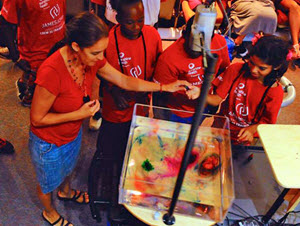
Professor Josefina Olascoaga assists camp kids in simulating the effect of the Earth’s spinning on currents by using a rotating tank and dye. (Photo provided by CARTHE)
After warming up the crowd with upbeat music, friendly banter, and just a little basketball talk, Jones let the kids see a different side of him. “I was a finance major in college and an academic all American,” he said, “I used basketball to get an education, but I’m not just a basketball player.”
Jones encouraged the kids to make friends with the science mentors, learn something new, and get outside their comfort zone. Then, he turned the program over to the enthusiastic CARTHE team and joined the group to learn right alongside them.
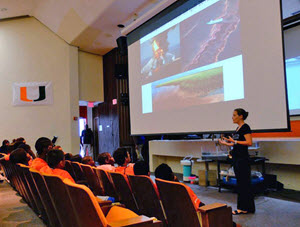
CARTHE Outreach Manager Laura Bracken teaches the group about the Deepwater Horizon oil spill and the importance of understanding how oil moves in the ocean. (Photo provided by CARTHE)
Laura Bracken, the CARTHE Outreach Manager, opened with the video “Bob the Drifter,” an animated depiction of their high-tech tracking devices that go with the flow of ocean currents, helping scientists understand how things move in water. She gave the example of the rubber ducks that, to this day, land in different parts of the world after a container full of them fell from a cargo ship in 1997. Professor Josefina Olascoaga, a physical oceanographer with CARTHE, asked the kids what they thought caused currents, getting answers like “wind,” “rain,” and “animals.” Using a rotating tank, she and post-doc Guillaume Novelli helped them see how the Earth’s spinning affects currents by adding dyes and watching swirling eddies form, taking the dyes in different directions.
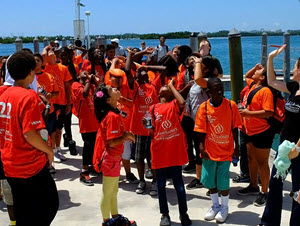
Campers watch as an airborne drone equipped with cameras is remotely maneuvered to capture images of them boarding the shark-tagging research vessel. (Photo provided by CARTHE)
Now, the team had the opening to relate currents and the oil spill. Bracken asked how many of them knew about the 2010 Deepwater Horizon oil spill. Only two raised their hands. The team explained what happened and how they were using science – and really cool equipment – to answer questions about how oil moves in the ocean. The kids got to see drifters and drones that CARTHE used in the GLAD and SCOPE experiments to understand surface currents in deep and in near-shore waters.
The week’s high-interest activities included a toad fish lab, a wave tank, sea slugs, corals, an aquarium, and aviation. A highlight of the program was a day spent catching and tagging sharks. Jones, who joined the kids every day, said he loved being able to expose them to things most people only see on television. “A lot of them thought this would be something similar to going to the zoo or the Seaquarium, but they’re actually out here baiting lines and taking blood and tagging sharks,” said Jones. “It’s something you see on Discovery Channel but rarely get a chance to do in person.”
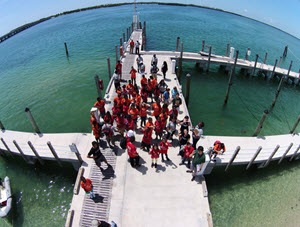
A drone’s perspective of the Jones Crew 22 campers as they gather to board a research vessel and tag sharks. (Photo provided by CARTHE)
CARTHE Director Tamay Özgökmen explained that, given the constant electronic distractions of our ADD world, outreach programs must be creative to bring science to the masses. He believes partnering with celebrities, such as sports stars and musicians, to host educational events provides an avenue to introduce new concepts when people are relaxed and open to ideas that might not ordinarily interest them. For this reason, CARTHE participated in the Tortugas Music Festival in April, where they spoke directly with over 500 individuals and brought scientific discovery to thousands. They hope to expand their reach to non-college audiences through films and other visual/audio media.
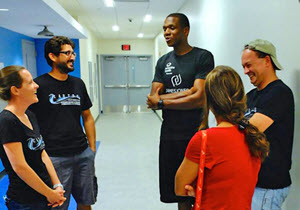
The CARTHE team chats with James Jones about the amazing experiences that the Crew 22 kids had during their week-long science camp. From L-R: CARTHE Outreach Manager Laura Bracken, post-doc Guillaume Novelli, Miami Heat Forward James Jones, CARTHE Director and Professor Tamay Ozgokmen, and Professor Josefina Olascoaga. (Photo provided by CARTHE)
And, partnering with the Jones Crew 22 camp has done just that. “I’ve always taken pride in finding new experiences,” said Jones. From the opening ceremony, where he got kids cheering and dancing, to the camp’s end, where he learned as their peer, Jones made science fun. Now, while most of these kids can say that Jones wears a size 16 shoe, they might also be able to tell their friends where the loop current goes, how currents move oil, or what it’s like reeling in a five-foot shark. For Jones and the CARTHE team, that means the week was a success.
Visit the CARTHE website for more information.
************
This research was made possible in part by grants from BP/The Gulf of Mexico Research Initiative (GoMRI) to the Consortium for Advanced Research on Transport of Hydrocarbon in the Environment (CARTHE). The GoMRI is a 10-year independent research program established to study the effect, and the potential associated impact, of hydrocarbon releases on the environment and public health, as well as to develop improved spill mitigation, oil detection, characterization and remediation technologies. An independent and academic 20-member Research Board makes the funding and research direction decisions to ensure the intellectual quality, effectiveness and academic independence of the GoMRI research. All research data, findings and publications will be made publicly available. The program was established through a $500 million financial commitment from BP. For more information, visit www.gulfresearchinitiative.org.
